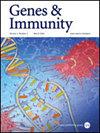了解子痫前期补体系统终末通路中罕见的遗传变异。
IF 4.5
3区 医学
Q1 GENETICS & HEREDITY
引用次数: 0
摘要
子痫前期是一种常见的多因素妊娠疾病。补体激活失调是疾病发病机制的新兴候选因素之一。在一项针对609名先兆子痫女性和2092名非先兆子痫对照组的靶向外显子组测序研究中,我们在9个编码膜攻击复合物(MAC, C5b-9)成分的基因中发现了14个与先兆子痫相关的变异。我们发现两个罕见的C5基因错义变异(rs200674959: I1296V, OR (CI95) = 24.13 (1.25-467.43), p值= 0.01)和rs147430470: I330T, OR (CI95) = 22.75 (1.17-440.78), p值= 0.01)易患子痫前期。此外,在C6 (rs41271067: D396G, OR (CI95) = 2.93 (1.18 ~ 7.10), p值= 0.01)和rs114609505: T190I, 0.02 OR (CI95) = 0.47 (0.22 ~ 0.92), p值= 0.02)中发现1个易感稀有变异和1个保护性稀有变异。结果表明,终末补体通路的变异易导致子痫前期。本文章由计算机程序翻译,如有差异,请以英文原文为准。

Understanding rare genetic variants within the terminal pathway of complement system in preeclampsia
Preeclampsia is a common multifactorial disease of pregnancy. Dysregulation of complement activation is among emerging candidates responsible for disease pathogenesis. In a targeted exomic sequencing study of 609 women with preeclampsia and 2092 non-preeclamptic controls, we identified 14 variants within nine genes coding for components of the membrane attack complex (MAC, C5b-9) that are associated with preeclampsia. We found two rare missense variants in the C5 gene that predispose to preeclampsia (rs200674959: I1296V, OR (CI95) = 24.13 (1.25–467.43), p value = 0.01 and rs147430470: I330T, OR (CI95) = 22.75 (1.17–440.78), p value = 0.01). In addition, one predisposing rare variant and one protective rare variant were discovered in C6 (rs41271067: D396G, OR (CI95) = 2.93 (1.18–7.10), p value = 0.01 and rs114609505: T190I, 0.02 OR (CI95) = 0.47 (0.22–0.92), p value = 0.02). The results suggest that variants in the terminal complement pathway predispose to preeclampsia.
求助全文
通过发布文献求助,成功后即可免费获取论文全文。
去求助
来源期刊

Genes and immunity
医学-免疫学
CiteScore
8.90
自引率
4.00%
发文量
28
审稿时长
6-12 weeks
期刊介绍:
Genes & Immunity emphasizes studies investigating how genetic, genomic and functional variations affect immune cells and the immune system, and associated processes in the regulation of health and disease. It further highlights articles on the transcriptional and posttranslational control of gene products involved in signaling pathways regulating immune cells, and protective and destructive immune responses.
 求助内容:
求助内容: 应助结果提醒方式:
应助结果提醒方式:


